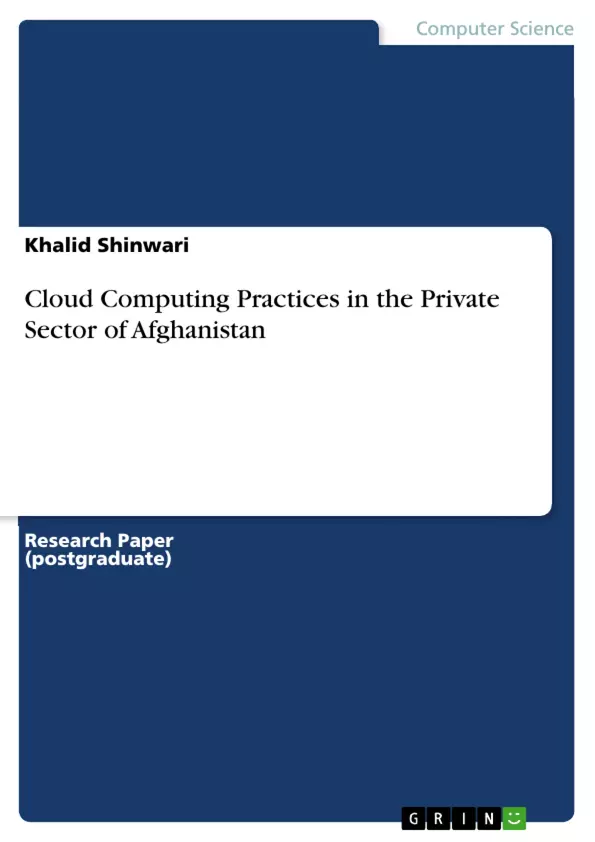This paper gives a general overview of how cloud computing is implemented in the private sector of Afghanistan. The private sector is kept under the discussion to see which cloud technologies are used and how they are implemented, the types of cloud services (IaaS, PaaS, SaaS) are used the most by them and the date sored on the cloud.
We will also discuss the challenges and risks they face, the benefits and favors they receive from the cloud, the problems that the cloud technologies solve for them, the future of the cloud is discussed and the organization's future plans are looked at.
Finally, the cloud practices in the private sector of Afghanistan are summarized and a conclusion is provided.
Inhaltsverzeichnis (Table of Contents)
- I. INTRODUCTION
- II. CLOUD COMPUTING
- III. LITERATURE REVIEW
- A. Wipro Limited
- B. Financial Companies
- C. Small and Medium Sized Enterprises
- IV. RESEARCH METHOD
- V. SAMPLING TECHNIQUES
- A. Netlinks IT Company
- B. HSOFT Technologies
- C. Kabul Camp
- D. Azizi Bank
- E. Ravish Institute
- F. VEKTI
- VI. ANALYSIS AND RESULTS
- A. Reasons behind the Cloud usage in the private sector of Afghanistan.
- B. The cloud technology used in the private organizations
- C. The Cloud Services used in the private organizations (SaaS, IaaS, PaaS)
- D. The benefits of the cloud services to the organizations
- VII. THE CHALLENGES AND RISKS
- E. Data Privacy
- F. Cost
- G. Downtime
- H. Service Providers Reliability
- I. Electricity Problems
- VIII. CONCLUSION
Zielsetzung und Themenschwerpunkte (Objectives and Key Themes)
This paper aims to explore the implementation of cloud computing in the private sector of Afghanistan. It analyzes the cloud technologies used, the benefits and challenges faced, and the future outlook of cloud computing in this context.
- Adoption of cloud technologies in the private sector of Afghanistan
- Benefits and challenges of using cloud services
- Specific cloud technologies and services employed
- Data privacy and security concerns associated with cloud computing
- The future of cloud computing in the Afghan private sector
Zusammenfassung der Kapitel (Chapter Summaries)
The introduction sets the context by discussing the widespread adoption of cloud computing globally and its impact on various sectors, particularly in India. It highlights the focus of the paper on the private sector of Afghanistan.
Chapter II provides a general overview of cloud computing, defining it as a model for providing on-demand access to shared computing resources. It traces the origins of the concept back to the early 1960s, with a specific focus on the National Institute of Standards and Technology (NIST) definition.
Chapter III delves into literature review, examining case studies of organizations that have successfully implemented cloud computing services. It discusses the experience of Wipro Limited, financial institutions, and small and medium-sized enterprises (SMEs).
Chapter IV outlines the research methodology used in the study, which involved conducting interviews and focused group discussions with IT professionals from various private organizations in Afghanistan.
Chapter V details the sampling techniques employed, outlining the companies and the number of professionals interviewed. It provides a comprehensive list of the organizations involved in the research.
Chapter VI presents an analysis of the data collected, focusing on the reasons for using cloud services, the specific cloud technologies implemented, and the types of cloud services employed (SaaS, IaaS, PaaS). It highlights the advantages experienced by organizations using cloud services.
Chapter VII explores the challenges and risks associated with cloud computing, including data privacy, costs, downtime, service provider reliability, and the impact of electricity problems in Afghanistan.
Schlüsselwörter (Keywords)
The primary focus of this paper lies on the application of cloud computing, its implementation, and the challenges and benefits it brings to the private sector in Afghanistan. Key terms include: cloud computing, private sector, Afghanistan, cloud services, data privacy, cost, downtime, service provider reliability, and electricity problems.
- Arbeit zitieren
- Khalid Shinwari (Autor:in), 2016, Cloud Computing Practices in the Private Sector of Afghanistan, München, GRIN Verlag, https://www.grin.com/document/503519



